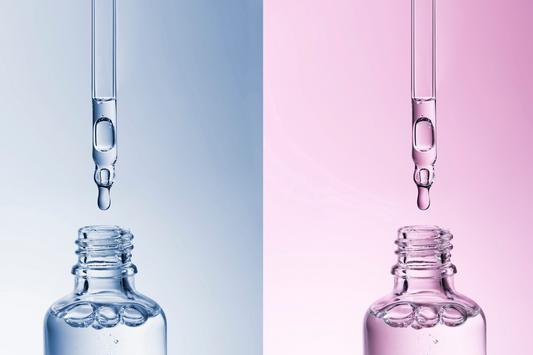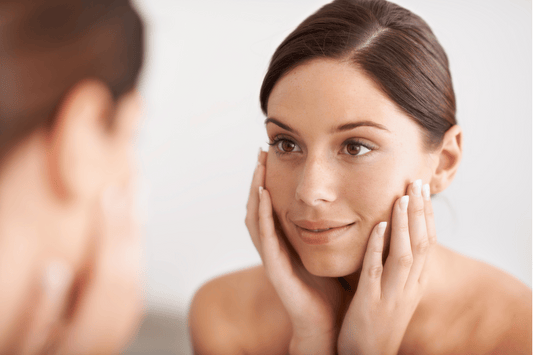Fine lines and wrinkles are a hot topic across the entire skin care community, especially in anti-aging products. While these two telltale signs become more pronounced as we age, one underlying property of skin aging that is not talked about as much is skin elasticity. What is skin elasticity and how does it contribute to the youthful lift we all aspire to achieve? Read on to learn what makes it so important.
What is skin elasticity?
Skin elasticity refers to our skin’s ability to “snap back” once it is stretched or altered from its resting shape. A classic example of this is the often-dreaded grandma cheek pinch.
But what does this have to do with skin aging? The phenomenon of skin aging is an inevitable process affecting all humans, and is accompanied by several signs, both visible and not. The visible signs of skin aging include wrinkles, fine lines, pigmentation (age spots) and uneven skin tones, etc. Another notable sign of skin aging is sagging. Just like a rubber band that’s been stretched one too many times, skin too begins to sag when it loses its elasticity.

The cutometer: a skin elasticity test
Skin elasticity can be measured using a cutometer. Using suction, the calibrated device creates negative pressure (a vacuum) to pull skin into an aperture and after a specific amount of time, releases it to measure viscoelastic properties of the skin.
What can cause a loss of skin elasticity?
The skin is the largest organ of the human body and consists of three layers: the epidermis, the dermis and the hypodermis. Within each layer, different types of cells, proteins, and tissues are present, working together to give skin its appearance and functional abilities.
Among these, collagen is a protein found deep in the dermis layer and is produced by specific cells, called dermal fibroblasts. Collagen, and the interweaving matrix of support it provides, is responsible for maintaining skin structure and —- yep, you got it —- skin elasticity.
As we age, the health of fibroblast cells decreases, causing the amount of collagen within the skin to decrease. As the skin begins to lose its supporting structure, we begin to observe a related loss in skin elasticity. Eventually it begins to sag, commonly leading to drooping facial features such as under eye bags.
External factors such as UV rays, pollution, stress, and lifestyle choices can also contribute to a loss in skin elasticity and advance the process of skin aging.

How to improve skin elasticity
While the entire process of collagen reduction, loss of skin elasticity and skin sagging may sound scary, it is an inevitable process. Therefore, while we should all definitely remain aware of it, the process is not one we should fear. The entire phenomenon is a gradual one, in that it takes time over the course of our entire lives. While we may not be able to stop it completely, here are some steps you can take to get ahead of it proactively and either maintain or regain elasticity in skin, allowing it to look healthy, youthful and glowing:
1. Sun protection acts as a skin protectant
Although getting as much sunlight as possible feels incredible sometimes, it is important to note that by spending a lot of time in the sun, you are exposing yourself to the harmful effects of Ultraviolet (UV) radiation. Research shows that the photodamage from UV rays hardens collagen and can cause a loss of skin elasticity. To prevent this, we recommend applying a liquid skin protectant ointment, such as a sunscreen with an SPF level of 30 and higher. Additionally, wearing protective clothing such as hats and long sleeved-attire can also be a powerful skin protectant!
2. Skin elasticity supplements & balanced nutrition
Diet and nutrition play crucial roles in all biological functions, both positively and negatively. In order to provide your body with the nutrients it needs to maintain skin elasticity and health, it is important to keep track of what kinds of food we are consuming and what kind of benefits, if any, they are providing us. Many people take vitamins for skin, most often in the form of supplements, capsules, or gummies. Common skin elasticity supplements include collagen, vitamin D, and omega-3 fatty acids. However, foods with high content of these will also provide sufficient nutrition. These include bone-broth, fish, skin-on chicken, and others.
3. Staying hydrated
It’s important to consume an ample amount of water daily to help support our skin’s health. As a general rule, you should drink 8 cups of water daily. This will help maintain skin elasticity and therefore, keep your skin looking plump and fresh! While the benefits of drinking cold water for skin versus warm water are sometimes debated, regularly consuming your daily recommended intake of good old H2O is always good for overall well-being.
4. Using products designed specifically for skin elasticity
While many products focus on wrinkles, skin elasticity is one of the more overlooked and difficult factors of skin aging. However, because of this, it is also one of the most important ones to address in order to keep our skin looking plump, lifted, and youthful.
Knowing this, the team of scientists at Revela used the latest technology in modern science to discover Fibroquin - a pro-collagen molecule designed specifically to improve skin elasticity, and the feature ingredient in the highly acclaimed Fibroquin Essence. Clinically proven to measurably improve skin elasticity by 21% over a period of just 8 weeks, the lightweight and hydrating cream focuses on the pro-collagen pathway by improving the health of fibroblast cells.






